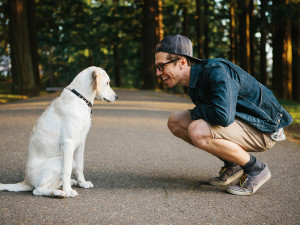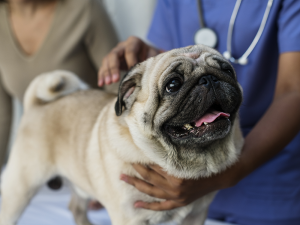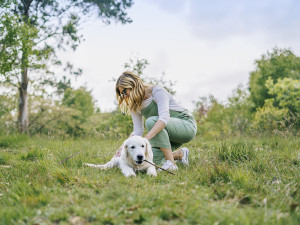9 Diseases You Can (and Definitely Can’t) Catch From Your Dog
Here’s what you can scratch off your “Worry About This” list.

Share Article
When a dog is diagnosed with an infectious disease, their parents tend to have the same round of anxious questions ready: “Will they get better?” “Can my other dog get it?” “Can I (or my kids) get it? ” When it comes to spreading to other dogs in the home, the answers vary, but when it comes to people, it is usually a definitive “no.” But, as with any scary or worrying thing in pet parenthood, there are some instances that should be cause for concern.
The main buzz words here: zoonotic diseases, or diseases that can be passed from animals to people. When people hear the word “zoonotic,” they tend to think of something like rabies (yikes!), but there are other diseases that dog parents should put on their “worry” list. But, for most, you can switch on on some Taylor Swift and calm downopens in new tab.
Diseases You Can Get From Your Dog
Intestinal parasites
Dogs come down with most intestinal parasites (ie. roundworms, hookworms, giardia) through fecal-oral transmission, which is exactly as gross as it sounds: Fecal matter makes its way into a host’s mouth and makes a new home. Because dogs explore their surroundings with their noses and tend to lick their paws, it’s easy to see how they can come in contact with infected stool. As a dog owner, you can pick up intestinal parasites if you eat or put your hands in your mouth after handling infected stool. This can happen after picking up after your dog or even after nail trims if their paws have been exposed to parasites. Hookworms and roundworms can also infect humans directly through the skin. This is most commonly seen when people walk barefoot through infested areas.
You can avoid intestinal parasites in your dog by making sure they are on monthly preventatives. For your part, practice good hand hygiene and be sure to wear shoes in areas dogs go to relieve themselves. Wash your hands thoroughly after cleaning up any pet waste and after grooming your pup.

Intestinal bacteria
Like intestinal parasites, bacteria such as Salmonella, Listeria, and Campylobacter can also be passed from dogs to people through fecal-oral transmission. Although Salmonella is typically considered a food-borne illness and is uncommon in dogs, the risk for this disease is increased in dogs who eat a raw diet.
When it comes to avoiding intestinal bacteria, the rules remain: Practice good hand hygiene and talk to your vet about the risks that come with raw food.
Skin Stuff
Ringworm, which is actually a fungus, causes areas of lost hair and flaky skin in puppies. Sarcoptic mange (scabies) is a mite that burrows under a dog’s skin and causes itching and hair loss. People can get both ringworm and scabies by coming into direct contact with these skin lesions. Dogs can also get bacterial skin infections or have infected wounds. The prevalence of resistant bacteria, such as methicillin-resistant Staphylococcus aureus (MRSA), is a concern in both human and veterinary medicine. Dogs and pet owners can infect each other if one has an antibiotic-resistant skin infection, though human to dog is more likely. Dogs can also become asymptomatic carriers of these bacteria.
To avoid skin infections for your dog, be prompt about having your dog checked out by a vet if they develop skin lesions or wounds. When it comes to your own safety, wash your hands after petting your dog while they are recovering from any skin issues (this hand-washing thing is becoming a common theme, huh?). If you have open wounds, keep them protected from your dog. Always practice good hygiene and talk to your vet about the risks that come with raw food.
Leptospirosis
Leptospirosis is a bacterial infection of the kidneys that can affect both dogs and people, typically through exposure to water contaminated with urine from infected animals. People can be infected by handling the blood or urine of an infected dog.
To stay safe from leptospirosis, wash your hands after handling any of your dog’s bodily fluids, even if they’re healthy. Don’t let your dog splash through or drink from standing water. Vaccination may also provide some protection. Talk to your vet to determine if a Leptospirosis vaccine is recommended for your dog.
Monkeypox
Monkeypox is a virus that causes fever, cough, runny nose, and skin lesions. The virus can be transmitted through direct contact, respiratory droplets, and contact with contaminated surfaces and bedding. As of early fall 2022, there has only been one reported case of infected pet parents transmitting monkeypox to their dog.
If a dog has been exposed or develops monkeypox symptoms, the dog should be isolated for 21 days to be monitored for development and/or recover from symptoms.
Rabies
Rabies is a neurological disease typically transmitted through bite wounds from infected animals. Rabies is nearly always fatal for dogs and people, so prevention is essential.
To stay safe from rabies, make sure your dog is vaccinated (it’s the lawopens in new tab!).
Diseases You Can’t Get From Your Dog
Heartworm
Heartworms are transmitted by mosquitoes and cause heart and lung disease in dogs. If a mosquito bites an infected dog, it can spread the infection along to the next dog it feeds on. This transmission is species-specific, so humans are not susceptible to heartworm disease, but dogs should definitely be on monthly preventatives.
Cold and Flu
One of the confusing aspects of dog illnesses is the fact that some share names with human illness. When people report outbreaks of canine influenza, it’s easy to come to the conclusion that humans are also at risk. One thing to remember is that many disease-causing viruses are species-specific, meaning they are very particular about what hosts they are able to live and thrive in. There is the rare species jump, but for the most part human flus are specific to humans and dog flus are specific to dogs.
Lice
Lice are small insects that live in hair/fur and feed on blood and dead skin. Lice infestations cause similar signs in dogs and humans: itching and flaking. The good news is that lice are pretty rare in dogs unless they are housed in crowded conditions. As fictional vet Dr. Ted Mullens taught us in Schitt’s Creek, lice are also species specific — dog lice only infect dogs and human lice only infect humans — so people and dogs can’t infect each other.
While it can sometimes seem that you and your dog are just asking to give each other cooties (all those sweet, sweet cuddles!), that’s definitely not the case. The best course of action is preventative care and prompt medical treatment that will keep you and your dog healthy. And remember, wash your dang hands, people!

Dr. Alycia Washington, DVM, MS
Alycia Washington is a small-animal emergency veterinarian with over 10 years of experience based in North Carolina. She works as a relief veterinarianopens in new tab and provides services to numerous emergency and specialty hospitals. She also works as a veterinary writer with a focus on educating pet parents.
Related articles
![White and black spotted Great Dane with two different colored eyes looks into the camera]()
Here’s How You Can Prevent Dangerous Bloat in Your Dog
Bloat is one of the leading causes of death in deep-chested dogs. This elective surgery can lower the risk.
![close up of Chihuahua dog's eye with cataracts]()
Common Eye Problems in Dogs and How to Treat Them
Your dog sees you as their best friend, so keep those eyes healthy.
![A woman checking her dog for ticks outside in a grassy field.]()
Can Dogs Get Lyme Disease? Canine Lyme Disease Symptoms, Treatment, and Prognosis
It is peak tick season, so we asked a veterinarian for tips on how to prevent this dreaded disease.







